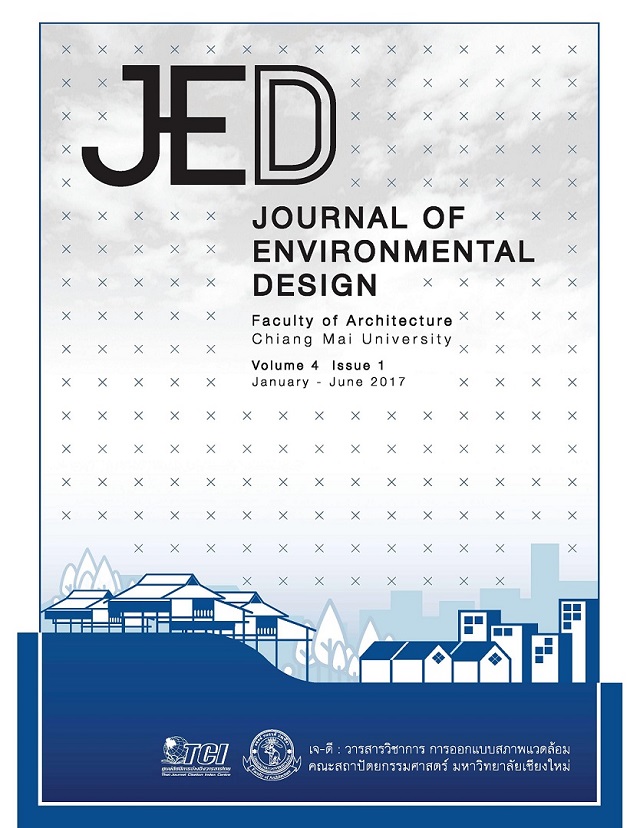เกณฑ์การออกแบบที่พักอาศัย สำหรับการท่องเที่ยวเชิงนิเวศในทัมลิงตาร์ ประเทศเนปาล (Accommodation design consideration for ecotourism in Tumlingtar, Nepal)
Main Article Content
บทคัดย่อ
การท่องเที่ยวเชิงนิเวศมีบทบาทสำคัญมากในการพัฒนาที่ยั่งยืน อีกทั้งยังเป็นการสร้างสภาพแวดล้อมและระบบนิเวศที่ดีให้กับสถานที่ท่องเที่ยวอย่างทัมลิงตาร์ (Tumlingtar) ประเทศเนปาล ธุรกิจการท่องเที่ยวเชิงนิเวศที่ทัมลิงตาร์ ส่วนใหญ่แล้วจะมาจากการปีนเขา การเดินเขา การล่องแก่ง และการชมสถานที่ธรรมชาติอื่นๆ นักท่องเที่ยวที่เดินทางไปเขามะกะลู (Makalu) และอุทยานแห่งชาติ ส่วนใหญ่จะพักที่ทัมลิงตาร์ อย่างน้อย 2-3 วัน ระหว่างการเดินทาง ทัมลิงตาร์เป็นสถานที่ที่เหมาะแก่การพักผ่อนและการท่องเที่ยวเชิงนิเวศเป็นอย่างยิ่ง การท่องเที่ยวและที่พักแบบประเพณีนิยมไม่สามารถแก้ปัญหาสังคมและวัฒนธรรม รวมถึงปัญหาสิ่งแวดล้อมที่ทัมลิงตาร์ได้ เช่น การมีโรงแรมขนาดเล็ก 5 แห่ง โดยไร้การวางแผนและออกแบบที่ดี ไม่มีการรักษาสภาพ และไม่มีการลงทุนที่ยั่งยืน จะไม่สามารถตอบสนองความต้องการของนักท่องเที่ยวที่ต้องการเที่ยวในเชิงธรรมชาติได้ อีกทั้งยังไม่สามารถสร้างรายได้และโอกาสให้กับคนพื้นถิ่นด้วย ความหมายที่แท้จริงของการท่องเที่ยวเชิงวัฒนธรรมได้หายไป ส่วนการพัฒนาที่ยั่งยืนก็ไม่สามารถเกิดขึ้นได้ ยิ่งไปกว่านั้น การที่ผู้คนในท้องถิ่นรู้เท่าไม่ถึงการณ์และพยายามหาทางแก้ไขตามแบบของตัวเอง ก็ยิ่งทำให้มันแย่ลง สิ่งที่สำคัญที่สุดคือการทำให้คนตระหนักและให้ความสำคัญกับการพัฒนาที่พักอาศัยที่ยั่งยืน เป็นมิตรต่อสภาพแวดล้อม และดำเนินตามหลักการท่องเที่ยวเชิงนิเวศ จุดมุ่งหมายของงานวิจัยนี้คือการกำหนดปัจจัยทางสังคมและวัฒนธรรม ปัจจัยทางสภาพแวดล้อม และปัจจัยทางเศรษฐกิจ ในการวางแผนและออกแบบที่พักสำหรับการท่องเที่ยวเชิงนิเวศที่ทัมลิงตาร์ ประเทศเนปาล ที่มุ่งเน้นไปยังแนวปฏิบัติที่ต้องใช้ในการวางแผนและออกแบบทางสถาปัตยกรรมของที่พักผ่านการวิเคราะห์พื้นที่ การวิเคราะห์พื้นที่สามารถวิเคราะห์โดยใช้ข้อมูลทางภูมิศาสตร์ ศักยภาพที่จะพัฒนาการท่องเที่ยวเชิงนิเวศ และการวิเคราะห์ SWOT งานวิจัยนี้จะช่วยให้คนพื้นถิ่นของทัมลิงตาร์ตระหนักถึงความสำคัญของการท่องเที่ยวเชิงนิเวศในชุมชน รวมถึงเป็นประโยชน์ต่อผู้เชี่ยวชาญในท้องถิ่น เช่น สถาปนิก นักวางแผน และนักออกแบบ เพื่อเป็นแนวทางในการออกแบบและพัฒนาที่พักในการท่องเที่ยวเชิงนิเวศต่อไป
Ecotourism plays an important role in sustainable development, promoting good environment and ecology of places like Tumlingtar, Nepal. Ecotourism business in Tumling- tar relies mostly on activities like mountain climbing, trekking, rafting and visiting natural sites. Tourist travelling to Makalu Mountain and National Park would stay at Tumlingtar for at least 2 to 3 days, while going and returning from the trip. It is a good place to stay or in other word an ecotourism accommodation in Tumlingtar. It was found that conventional tourism and accommodation practice failed to solve socio cultural and environmental issues of Tumlingtar. For instance, presence of only 5 small hotels, without good planning and design, good maintenance and no sustainable efforts failed to fulfill the demand of eco tourists as well failed to generate enough income and opportunities for local people. The true meaning of ecotourism was lost and sustainable development was just a paradox. People were and are unware of these issues and are trying to find their own solutions fol- lowing conventional footsteps, which is making the situation worst. The main necessity here is to make them aware and give them technical ideas of developing accommodation, which is sustainable, environment friendly and follows the idea of ecotourism. The objective of this study was to determine socio-cultural, environmental and economic factors for planning and designing accommodation for ecotourism in Tumlingtar, Nepal. This study focuses on guidelines that need to be considered for architectural planning and design of accommoda- tion through the understanding of detailed site analysis. Site analysis can be done through analyzing geographic information, its potential for ecotourism and SWOT analysis. Because of this study, local people of Tumlingtar will be aware of importance of ecotourism in their place and the professional community like architects, planners and designers will find this study as a guiding tool to design and develop accommodation for ecotourism.


